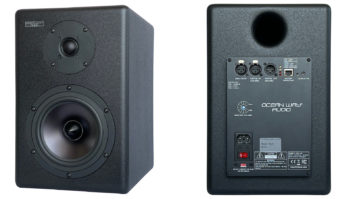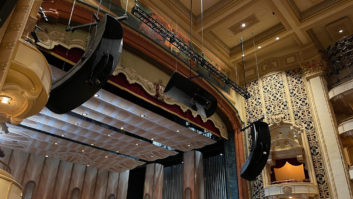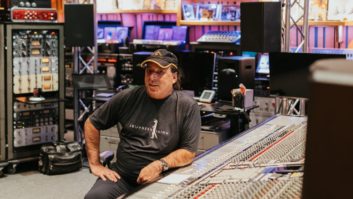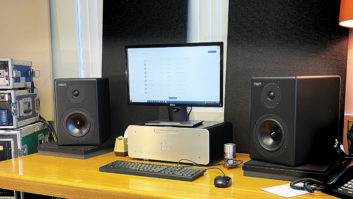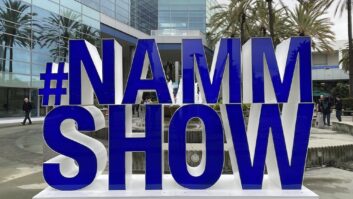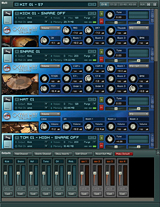
OWD comes with six preset mixes per kit that can be altered by the user.
The first world-class studio I ever set foot in was Ocean Way in Hollywood. The Gold and Platinum albums lining the walls beamed an aura of the immense talent of those who worked there. Now, Sonic Reality’s Ocean Way Drums (OWD) drum-sample library packages the sound, rooms and one-of-a-kind mic collection found in that special place. Ocean Way studio owner Allen Sides and engineer Steven Miller spent two years painstakingly recording and creating the collection. There are no loops, pre-sequenced grooves or step sequences; OWD focuses on individual drum hits, delivered via Native Instruments’ Kontakt 2 sample player, and available in all the usual plug-in formats.
OWD’s 19 drum kits cover the gamut from loose-sounding vintage drums to tight modern sets. Snares range from deep rock to popping piccolos, and include rolls, rim shots and ghost notes. Cymbals include tiny splashes to big rides, and feature numerous variations: bell hits, chokes, multiple edge hits and rolls. Hi-hats include sloppy, open rock sounds and crisp jazz timbres — with multiple open-hat positions. All instruments were hit with a stick — no brush or mallet samples.
PICK YOUR PACKAGE
The $995 Gold edition has 40 GB of 48kHz samples spread over 19 different kits. Offering the same sets at 96 kHz, plus extra kick drums, the 120GB Platinum edition ($1,995) is pre-installed on a USB 2/FireWire hard drive. All kits have presets mapped for General MIDI or Sonic Reality’s IMAP format for greater flexibility when playing “keyboard drums.”
OWD makes heavy use of Kontakt’s direct-from-disk feature, which streams samples from the hard drive. Most instruments stream 10 or more channels per drum hit so it’s easy to exceed 40 audio channels when multiple drums are played at once; therefore, OWD should run on its own (7,200 rpm or faster) hard drive. I had no problems using the Audio Units version of OWD in Apple Logic Pro 8.
Opening OWD in Logic presents a version of Kontakt 2 that’s tailored for OWD. To me, the Kontakt workspace felt unintuitive, and users of plug-ins like BFD or Addictive Drums will probably want more from the interface. There are no images of the actual sampled drums, and the labels for selecting kits and drums are generic, such as “Kit 1” or “Snare Drum 2.” This convention isn’t very useful when trying to find a piccolo snare.
On the other hand, using your ears to sift through the options is not necessarily a bad thing when listening to drums that sound so good. Ocean Way’s custom-built analog console yields drums with sparkling transient detail and a warm, defined bottom end. Many drums also feature an option for blending samples that were processed through hard-to-find gear such as an AMS RMX-16 digital reverb — a coveted mainstay in high-end studios.
Complete drum kit presets come in the form of what Kontakt refers to as “multis.” Each drum in the kit is then represented by an instrument block with gain knobs for each available channel, such as U47, AKG, OH, Room 1, etc. A pull-down menu can display channel panners, envelope settings or a velocity view to tailor how the drum responds dynamically to how hard you play your controller. These controls are independent on every instrument and allow creative options that aren’t possible with a conventionally recorded kit, such as shortening the decay on the kick’s room mics while leaving a long room decay on the snare.
I had fun with the snares. Each kit has snare-on and snare-off versions. In snare-off presets, the other drums in the kit, such as toms and kick, were played without snare rattle bleeding into the mics. One approach I loved was using stereo AKG C-12s about 18 inches over the snare and two rare Sony 55Ps (also in stereo) for snare bottom. This unique flavor sounded wonderful. For contrast, the snares were also recorded with Shure SM57s in more traditional positions.
With this many controls available, balancing the relative instruments within a kit could prove difficult, so OWD combines various channels from each instrument onto more manageable buses. The buses are represented in Kontakt’s mixer as kick, snare, hat and toms, along with overhead and ambience channels. Each bus has its own volume fader and includes multiple insert slots for additional processing.
To get quick results without having to build a sound from scratch, each kit has six ready-to-go preset mixes. I wouldn’t typically think that “producing by preset” would be useful, but these settings are almost like being part of a Sides clinic on mixing drums.
ALL ABOUT THE SOUND
What matters most is how drums sound in the mix. Playing sequenced drums from some of my projects, I quickly re-assigned them to OWD. I found it unnecessary to use any additional processing with OWD; I just blended the provided mics to my liking and simply let the undoctored samples shine through. As a bonus, at press time, Sonic Reality announced that users can drive OWD from Drumagog by downloading either MidiPipe (Mac) or MIDI Yoke (PC).
I’m not a fan of the Kontakt interface, but the drum sounds sold me on OWD. The mic choices, the room, processing options and the excellent recordings make this a one-of-a-kind collection. OWD brings you the sound of a unique and special place — even if you’ve never set foot on the Sunset Strip.
Sonic Reality, www.sonicreality.com.
Robert Brock is an engineer, music producer, composer and pianist.
